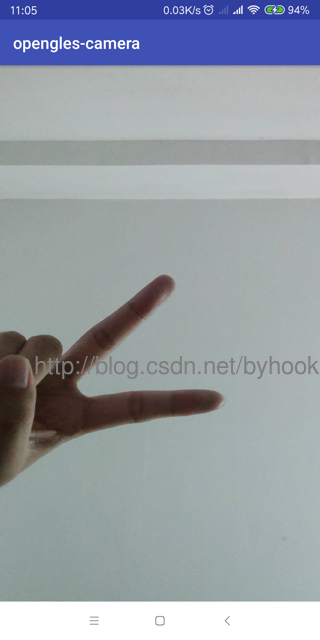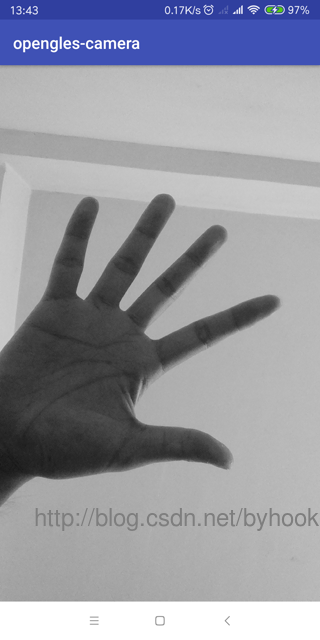OpenGL ES 3.0学习实践
- android平台下OpenGL ES 3.0从零开始
- android平台下OpenGL ES 3.0绘制纯色背景
- android平台下OpenGL ES 3.0绘制圆点、直线和三角形
- android平台下OpenGL ES 3.0绘制彩色三角形
- android平台下OpenGL ES 3.0从矩形中看矩阵和正交投影
- android平台下OpenGL ES 3.0着色语言基础知识(上)
- android平台下OpenGL ES 3.0着色语言基础知识(下)
- android平台下OpenGL ES 3.0实例详解顶点属性、顶点数组
- android平台下OpenGL ES 3.0实例详解顶点缓冲区对象(VBO)和顶点数组对象(VAO)
- android平台下OpenGL ES 3.0绘制立方体的几种方式
- android平台下OpenGL ES 3.0实现2D纹理贴图显示bitmap
- android平台下OpenGL ES 3.0基于GLSurfaceView对相机Camera预览实时处理
相机预览数据格式
android相机输出的原始数据格式一般都是NV21(实际上就是YUV420SP的格式)或者NV12(实际上就是YUV420P的格式),笔者的小米MIX 2S的默认输出格式就是NV21的,关于格式的问题,后续博客再详细说明。
前面的博客以及说明了如何通过OpenGL ES来渲染图像,一般YUV格式的数据是无法直接用OpenGL ES来渲染的,而在OpenGL中使用的绝大部分纹理ID都是RGBA的格式,在OpenGL ES 3.0的扩展#extension GL_OES_EGL_image_external_essl3定义了一个纹理的扩展类型,即GL_TEXTURE_EXTERNAL_OES,否则整个转换过程将会非常复杂。同时这种纹理目标对纹理的使用方式也会有一些限制,纹理绑定需要绑定到类型GL_TEXTURE_EXTERNAL_OES上,而不是类型GL_TEXTURE_2D上,对纹理设置参数也要使用GL_TEXTURE_EXTERNAL_OES类型,生成纹理与设置纹理参数的代码如下:
int[] tex = new int[1];
//创建一个纹理
GLES30.glGenTextures(1, tex, 0);
//绑定到外部纹理上
GLES30.glBindTexture(GLES11Ext.GL_TEXTURE_EXTERNAL_OES, tex[0]);
//设置纹理过滤参数
GLES30.glTexParameterf(GLES11Ext.GL_TEXTURE_EXTERNAL_OES, GLES30.GL_TEXTURE_MIN_FILTER, GLES30.GL_NEAREST);
GLES30.glTexParameterf(GLES11Ext.GL_TEXTURE_EXTERNAL_OES, GLES30.GL_TEXTURE_MAG_FILTER, GLES30.GL_LINEAR);
GLES30.glTexParameterf(GLES11Ext.GL_TEXTURE_EXTERNAL_OES, GLES30.GL_TEXTURE_WRAP_S, GLES30.GL_CLAMP_TO_EDGE);
GLES30.glTexParameterf(GLES11Ext.GL_TEXTURE_EXTERNAL_OES, GLES30.GL_TEXTURE_WRAP_T, GLES30.GL_CLAMP_TO_EDGE);
在实际的渲染过程中绑定纹理的代码如下:
GLES30.glActiveTexture(GL_TEXTURE0);
GLES30.glBindTexture(GL_TEXTURE_EXTERNAL_OES, textureId);
GLES30.glUniform1i(uniformSamplers, 0);
在OpenGL ES的顶点着色器中,任何需要从纹理中采样的OpenGL ES的顶点着色器都需要声明其对此扩展的使用,使用指令如下:
//这行是OpenGL ES 2.0中的声明
#extension GL_OES_EGL_image_external : require
//这行是OpenGL ES 3.0中的声明
#extension GL_OES_EGL_image_external_essl3 : require
上面的过程就是使用这种扩展类型的纹理ID从创建到设置参数,再到真正的渲染整个过程,接下来再根据一个完整的示例看一下具体的旋转角度问题,因为在使用摄像头的时候很容易在预览的时候会出现倒立、镜像等问题。
开始项目实践
先不多说,直接实践看效果,基于之前的项目工程,新建CameraSurfaceRenderer.java文件:
/**
* @anchor: andy
* @date: 2018-11-09
* @description: 基于相机
*/
public class CameraSurfaceRenderer implements GLSurfaceView.Renderer {
private static final String TAG = "TextureRenderer";
private final FloatBuffer vertexBuffer, mTexVertexBuffer;
private final ShortBuffer mVertexIndexBuffer;
private int mProgram;
private int textureId;
/**
* 顶点坐标
* (x,y,z)
*/
private float[] POSITION_VERTEX = new float[]{
0f, 0f, 0f, //顶点坐标V0
1f, 1f, 0f, //顶点坐标V1
-1f, 1f, 0f, //顶点坐标V2
-1f, -1f, 0f, //顶点坐标V3
1f, -1f, 0f //顶点坐标V4
};
/**
* 纹理坐标
* (s,t)
*/
private static final float[] TEX_VERTEX = {
0.5f, 0.5f, //纹理坐标V0
1f, 1f, //纹理坐标V1
0f, 1f, //纹理坐标V2
0f, 0.0f, //纹理坐标V3
1f, 0.0f //纹理坐标V4
};
/**
* 索引
*/
private static final short[] VERTEX_INDEX = {
0, 1, 2, //V0,V1,V2 三个顶点组成一个三角形
0, 2, 3, //V0,V2,V3 三个顶点组成一个三角形
0, 3, 4, //V0,V3,V4 三个顶点组成一个三角形
0, 4, 1 //V0,V4,V1 三个顶点组成一个三角形
};
private float[] transformMatrix = new float[16];
/**
* 渲染容器
*/
private GLSurfaceView mGLSurfaceView;
/**
* 相机ID
*/
private int mCameraId;
/**
* 相机实例
*/
private Camera mCamera;
/**
* Surface
*/
private SurfaceTexture mSurfaceTexture;
/**
* 矩阵索引
*/
private int uTextureMatrixLocation;
private int uTextureSamplerLocation;
public CameraSurfaceRenderer(GLSurfaceView glSurfaceView) {
this.mCameraId = Camera.CameraInfo.CAMERA_FACING_FRONT;
this.mGLSurfaceView = glSurfaceView;
mCamera = Camera.open(mCameraId);
setCameraDisplayOrientation(mCameraId, mCamera);
//分配内存空间,每个浮点型占4字节空间
vertexBuffer = ByteBuffer.allocateDirect(POSITION_VERTEX.length * 4)
.order(ByteOrder.nativeOrder())
.asFloatBuffer();
//传入指定的坐标数据
vertexBuffer.put(POSITION_VERTEX);
vertexBuffer.position(0);
mTexVertexBuffer = ByteBuffer.allocateDirect(TEX_VERTEX.length * 4)
.order(ByteOrder.nativeOrder())
.asFloatBuffer()
.put(TEX_VERTEX);
mTexVertexBuffer.position(0);
mVertexIndexBuffer = ByteBuffer.allocateDirect(VERTEX_INDEX.length * 2)
.order(ByteOrder.nativeOrder())
.asShortBuffer()
.put(VERTEX_INDEX);
mVertexIndexBuffer.position(0);
}
private void setCameraDisplayOrientation(int cameraId, Camera camera) {
Activity targetActivity = (Activity) mGLSurfaceView.getContext();
android.hardware.Camera.CameraInfo info =
new android.hardware.Camera.CameraInfo();
android.hardware.Camera.getCameraInfo(cameraId, info);
int rotation = targetActivity.getWindowManager().getDefaultDisplay()
.getRotation();
int degrees = 0;
switch (rotation) {
case Surface.ROTATION_0: degrees = 0; break;
case Surface.ROTATION_90: degrees = 90; break;
case Surface.ROTATION_180: degrees = 180; break;
case Surface.ROTATION_270: degrees = 270; break;
}
int result;
if (info.facing == Camera.CameraInfo.CAMERA_FACING_FRONT) {
result = (info.orientation + degrees) % 360;
result = (360 - result) % 360; // compensate the mirror
} else { // back-facing
result = (info.orientation - degrees + 360) % 360;
}
camera.setDisplayOrientation(result);
}
/**
* 加载外部纹理
* @return
*/
public int loadTexture() {
int[] tex = new int[1];
//创建一个纹理
GLES30.glGenTextures(1, tex, 0);
//绑定到外部纹理上
GLES30.glBindTexture(GLES11Ext.GL_TEXTURE_EXTERNAL_OES, tex[0]);
//设置纹理过滤参数
GLES30.glTexParameterf(GLES11Ext.GL_TEXTURE_EXTERNAL_OES, GLES30.GL_TEXTURE_MIN_FILTER, GLES30.GL_NEAREST);
GLES30.glTexParameterf(GLES11Ext.GL_TEXTURE_EXTERNAL_OES, GLES30.GL_TEXTURE_MAG_FILTER, GLES30.GL_LINEAR);
GLES30.glTexParameterf(GLES11Ext.GL_TEXTURE_EXTERNAL_OES, GLES30.GL_TEXTURE_WRAP_S, GLES30.GL_CLAMP_TO_EDGE);
GLES30.glTexParameterf(GLES11Ext.GL_TEXTURE_EXTERNAL_OES, GLES30.GL_TEXTURE_WRAP_T, GLES30.GL_CLAMP_TO_EDGE);
//解除纹理绑定
GLES30.glBindTexture(GLES11Ext.GL_TEXTURE_EXTERNAL_OES, 0);
return tex[0];
}
@Override
public void onSurfaceCreated(GL10 gl, EGLConfig config) {
//设置背景颜色
GLES30.glClearColor(0.5f, 0.5f, 0.5f, 0.5f);
//编译
final int vertexShaderId = ShaderUtils.compileVertexShader(ResReadUtils.readResource(R.raw.vertex_camera_shader));
final int fragmentShaderId = ShaderUtils.compileFragmentShader(ResReadUtils.readResource(R.raw.fragment_camera_shader));
//链接程序片段
mProgram = ShaderUtils.linkProgram(vertexShaderId, fragmentShaderId);
uTextureMatrixLocation = GLES30.glGetUniformLocation(mProgram, "uTextureMatrix");
//获取Shader中定义的变量在program中的位置
uTextureSamplerLocation = GLES30.glGetUniformLocation(mProgram, "yuvTexSampler");
//加载纹理
textureId = loadTexture();
//加载SurfaceTexture
loadSurfaceTexture(textureId);
}
@Override
public void onSurfaceChanged(GL10 gl, int width, int height) {
GLES30.glViewport(0, 0, width, height);
}
@Override
public void onDrawFrame(GL10 gl) {
GLES30.glClear(GLES30.GL_COLOR_BUFFER_BIT);
//使用程序片段
GLES30.glUseProgram(mProgram);
//更新纹理图像
mSurfaceTexture.updateTexImage();
mSurfaceTexture.getTransformMatrix(transformMatrix);
//激活纹理单元0
GLES30.glActiveTexture(GLES30.GL_TEXTURE0);
//绑定外部纹理到纹理单元0
GLES30.glBindTexture(GLES11Ext.GL_TEXTURE_EXTERNAL_OES, textureId);
//将此纹理单元床位片段着色器的uTextureSampler外部纹理采样器
GLES30.glUniform1i(uTextureSamplerLocation, 0);
//将纹理矩阵传给片段着色器
GLES30.glUniformMatrix4fv(uTextureMatrixLocation, 1, false, transformMatrix, 0);
GLES30.glEnableVertexAttribArray(0);
GLES30.glVertexAttribPointer(0, 3, GLES30.GL_FLOAT, false, 0, vertexBuffer);
GLES30.glEnableVertexAttribArray(1);
GLES30.glVertexAttribPointer(1, 2, GLES30.GL_FLOAT, false, 0, mTexVertexBuffer);
// 绘制
GLES20.glDrawElements(GLES20.GL_TRIANGLES, VERTEX_INDEX.length, GLES20.GL_UNSIGNED_SHORT, mVertexIndexBuffer);
}
public boolean loadSurfaceTexture(int textureId) {
//根据纹理ID创建SurfaceTexture
mSurfaceTexture = new SurfaceTexture(textureId);
mSurfaceTexture.setOnFrameAvailableListener(new SurfaceTexture.OnFrameAvailableListener() {
@Override
public void onFrameAvailable(SurfaceTexture surfaceTexture) {
mGLSurfaceView.requestRender();
}
});
//设置SurfaceTexture作为相机预览输出
try {
mCamera.setPreviewTexture(mSurfaceTexture);
} catch (IOException e) {
e.printStackTrace();
return false;
}
//开启相机预览
mCamera.startPreview();
return true;
}
}
顶点着色器:
#version 300 es
layout (location = 0) in vec4 vPosition;
layout (location = 1) in vec4 aTextureCoord;
//纹理矩阵
uniform mat4 uTextureMatrix;
out vec2 yuvTexCoords;
void main() {
gl_Position = vPosition;
gl_PointSize = 10.0;
//只保留x和y分量
yuvTexCoords = (uTextureMatrix * aTextureCoord).xy;
}
片段着色器:
#version 300 es
//OpenGL ES3.0外部纹理扩展
#extension GL_OES_EGL_image_external_essl3 : require
precision mediump float;
uniform samplerExternalOES yuvTexSampler;
in vec2 yuvTexCoords;
out vec4 vFragColor;
void main() {
vFragColor = texture(yuvTexSampler,yuvTexCoords);
}
注意: 外部纹理扩展在OpenGL ES 2.0和OpenGL ES 3.0中不太一样。
//OpenGL ES2.0外部纹理扩展
#extension GL_OES_EGL_image_external : require
在启动的Activity中处理初始化的部分:
private void setupView() {
//实例化一个GLSurfaceView
mGLSurfaceView = new GLSurfaceView(this);
mGLSurfaceView.setEGLContextClientVersion(3);
mGLSurfaceView.setRenderer(new CameraSurfaceRenderer(mGLSurfaceView));
setContentView(mGLSurfaceView);
}
来个剪刀手看看效果:


简单的滤镜处理
通过纹理将相机采集的数据渲染到GLSurfaceView的过程中,我们也可以添加各种滤镜。
给相机添加黑白滤镜,修改片段着色器
#version 300 es
//OpenGL ES3.0外部纹理扩展
#extension GL_OES_EGL_image_external_essl3 : require
precision mediump float;
uniform samplerExternalOES yuvTexSampler;
in vec2 yuvTexCoords;
out vec4 vFragColor;
void main() {
vec4 vCameraColor = texture(yuvTexSampler,yuvTexCoords);
float fGrayColor = (0.3*vCameraColor.r + 0.59*vCameraColor.g + 0.11*vCameraColor.b);
vFragColor = vec4(fGrayColor, fGrayColor, fGrayColor, 1.0);
}

可以参照下面的几个转换公式:
标清电视使用的标准BT.601
标清电视使用的标准BT.709
相机从采集到显示的过程
上述的例子完整的实现了相机预览数据通过OpenGL ES 3.0实时渲染到GLSurfaceView上。但是如果你稍不注意,很可能会出现手机摄像头预览的时候会出现倒立、镜像等问题,下面来看看这个过程。
前置摄像头从采集到最终显示的过程:

后置摄像头从采集到最终显示的过程:

OpenGL坐标:

OpenGL二维纹理坐标:

不做任何旋转的纹理坐标:
private static final float[] TEX_VERTEX = {
0.0f, 0.0f, //图像左下角
1.0f, 0.0f, //图像右下角
0.0f, 1.0f, //图像左上角
1.0f, 1.0f //图像右上角
};
顺时针旋转90度的纹理坐标:(可以想象一下将上述的OpenGL二维纹理坐标顺时针旋转90度)
private static final float[] TEX_VERTEX = {
1.0f, 0.0f, //图像右下角
1.0f, 1.0f, //图像右上角
0.0f, 0.0f, //图像左下角
0.0f, 1.0f //图像左上角
};
顺时针旋转180度的纹理坐标:
private static final float[] TEX_VERTEX = {
1.0f, 0.0f, //图像右下角
0.0f, 1.0f, //图像左上角
1.0f, 1.0f, //图像右上角
0.0f, 0.0f //图像左下角
};
顺时针旋转270度的纹理坐标:
private static final float[] TEX_VERTEX = {
0.0f, 1.0f, //图像左上角
0.0f, 0.0f, //图像左下角
1.0f, 1.0f, //图像右上角
1.0f, 0.0f //图像右下角
};
我们再来看看之前说的计算机中的图像坐标系:

所以我们实际在处理相机的预览图像时要对每一个纹理坐标做一个VFlip的变换(即把每一个顶点的y值由0变为1或者由1变为0),这样就可以得到一个正确的图像旋转了。而前置摄像头还存在镜像的问题,因此需要对每一个纹理坐标做一个HFlip的变换(即把每一个顶点的x值由0变为1或者由1变为0),从而让图片在预览界面中看起来就像在镜子中的一样。
项目地址:
https://github.com/byhook/opengles4android
参考:
https://blog.csdn.net/lb377463323/article/details/77071054#t0
《音视频开发进阶指南》